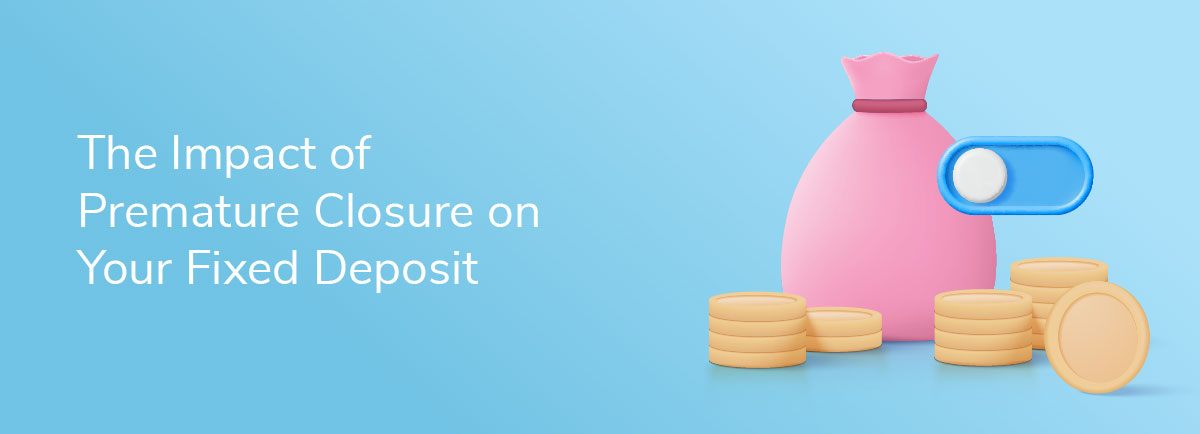
The Impact of Premature Closure on Your Fixed Deposit
19 July 2024 | By INDIE
If you are planning to withdraw your Fixed Deposit (FD) prematurely, then take a pause because there are consequences. FDs are highly appreciated for their consistent returns, security, and simplicity. You invest a lump sum, select a tenure, and enjoy stable FD interest rates throughout the chosen tenure.
However, when you decide to withdraw early, you diminish the benefits of fixed deposits that you might have enjoyed by holding them until maturity. Having said that, let's understand the impact of early FD closure and strategies you can use to meet monetary needs without premature withdrawals.
1. Penalties
If you break your FD before it matures, you may incur a penalty, which usually ranges between 0.5% and 1% on the interest rate.
For example, if your FD originally offered an annual interest rate of 5% and you faced a 1% penalty for early withdrawal, then you will earn only 4% as interest. So, FD breaking charges can greatly impact your return calculations and the growth of your invested funds.
2. Interest loss and interrupted compounding growth
When you terminate a fixed deposit early, the interest rate you receive is often lower than the rate initially agreed upon for the full term. Banks have the right to adjust the rate to match the actual duration for which the deposit was held.
Moreover, fixed deposit schemes benefit from the power of compounding, particularly those held over the long term. Withdrawing early disrupts this process, and you miss out on the compound interest that would have accumulated on your returns over time.
3. Impact on your financial targets
Many investors rely on the FD returns for various financial goals like children's education, retirement, or purchasing property. Premature withdrawals disrupt this financial planning because the returns will be less than expected.
This might force investors to modify their plans or look for other investment options, which may not be as safe or may need additional time to yield similar returns.
When does the premature closure of FD schemes actually make sense?
If you find better FD interest rates at another bank, premature withdrawals may make sense.
For example, you can book an INDIE Fixed Deposit to enjoy an interest rate of up to 7.75% p.a. You can even link your FD to your savings account and make payments directly from the deposit whenever your bank balance is insufficient. Since you have 24/7 access to your funds, you won't have to break your FD for monetary needs.
Download the INDIE app by IndusInd Bank and book your INDIE Fixed Deposit today with a 100% digital process!
Alternatives to premature FD withdrawal
Loan against FD |
You can pledge your FD as collateral to obtain a loan in return. Many banks offer loans of up to 90-95% of your FD's value. |
Laddering your FDs |
Spread your capital across multiple FDs with different maturity dates to maintain access to some funds without disturbing the rest of your investment. |
Multiple payout options |
Choose FDs that allow for interest payouts at different intervals (monthly, quarterly, etc.) to enjoy regular income streams and reduce the need to break FDs. |
Prioritise FDs smartly |
If you need cash quickly, break the deposit with the nearest maturity or lowest FD interest rate. This reduces the penalties or loss of interest and protects your higher-earning FDs. |
To sum up
Premature withdrawal of deposits means you lose out on interest, incur FD breaking charges, interrupt compounding, and delay your goals. As such, it makes sense to explore alternatives instead of breaking your FD before its term.
Strategies like taking out a loan against your FD, choosing multiple payout options, and laddering FDs can help you reduce the need for premature withdrawals. Put simply, assess your options thoroughly to make sure that your withdrawal decisions reflect your financial prudence
Disclaimer: The information provided in this article is generic and for informational purposes only. It is not a substitute for specific advice in your circumstances. Hence, you are advised to consult your financial advisor before making any financial decision. IndusInd Bank Limited (IBL) does not influence the views of the author in any way. IBL and the author shall not be responsible for any direct/indirect loss or liability incurred by the reader for making any financial decisions based on the contents and information.




